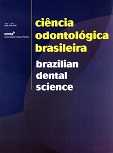Associação entre aleitamento, hábitos de sucção não-nutritivos e maloclusões em crianças de 3 a 5 anos
DOI:
https://doi.org/10.14295/bds.2008.v11i1.319Abstract
Verificar a prevalência e a associação dos tipos e tempo de aleitamento, hábitos de sucção não-nutritivos e maloclusões em 733 pré-escolares de 3 a 5anos, matriculados em creches municipais de João Pessoa (PB). Métodos: O presente estudo é do tipo transversal e clínico-epidemiológico. A amostra foi calculada mediante o cálculo amostral do universo de pré-escolares matriculados. Aplicou-se o formulário aos responsáveis e a ficha clínica às crianças e, para a confiabilidade dos resultados, foi realizado o teste de Kappa. Os dados foram submetidos aos testes do Qui-Quadrado, Razão de Verossimilhança e Exato de Fisher (p<0,05).Resultados: Do total da amostra, 16,4 receberam aleitamento natural, 10,9%, aleitamento artificial e 72,7%, aleitamento misto. Observou-se associação entre os tipos de aleitamento e os hábitos de sucção não-nutritivos (p<0,001), verificando-se uma maior prevalência de sugadores de chupeta dentre os pré-escolares que receberam aleitamento artificial (66,2%) e misto (61,9%). O hábito de sucção de chupeta foi influenciado pela duração do aleitamento misto (p<0,001), não sendo esta relação constatada para a sucção digital (p>0,05). Evidenciou-se uma prevalência mais elevada de sobressaliência severa (15,7%), sobremordida severa (16,5%) e mordida aberta anterior (51%) nos sugadores de chupeta (p<0,0001). Constatou-se ainda uma relação entre o hábito de sucção digital com a sobressaliência (p<0,01) e sobremordida (p<0,05).
Conclusão: Conclui-se que há diferenças significativas entre os tipos e tempo de aleitamento com o hábito de sucção de
chupeta, bem como entre este hábito e a presença de algumas maloclusões, estando a sucção digital significativamente associada à sobressaliência e sobremordida.
Downloads
Downloads
Published
How to Cite
Issue
Section
License
Brazilian Dental Science uses the Creative Commons (CC-BY 4.0) license, thus preserving the integrity of articles in an open access environment. The journal allows the author to retain publishing rights without restrictions.
=================




























